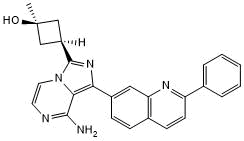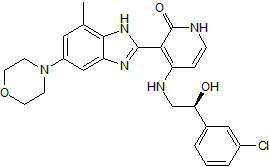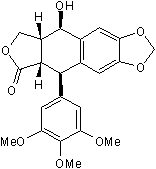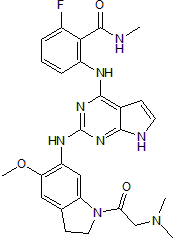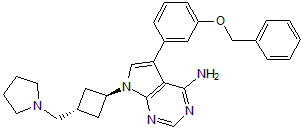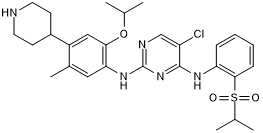Insulin and Insulin-like Receptor Inhibitors Products
IGF-I receptor is a disulfide-linked heterotetrameric transmembrane protein consisting of two alpha and two beta subunits. Both the alpha and beta subunits are encoded within a single receptor precursor cDNA. The proreceptor polypeptide is proteolytically cleaved and disulfide-linked to yield the mature heterotetrameric receptor. The alpha subunit of IGF-I receptor is extracellular while the beta subunit has an extracellular domain, a transmembrane domain and a cytoplasmic tyrosine kinase domain. The IGF-I receptor is highly expressed in all cell types and tissues.
IGF-II R is a type I transmembrane glycoprotein that contains a 2,264 amino acid (aa) extracellular region, a 23 aa transmembrane segment segment and a 124 aa cytoplasmic tail. IGF-II R regulates many diverse biological functions that range from intracellular trafficking to the internalization of extracellular factors and modulation of cellular responses. It delivers newly synthesized M6P-tagged lysosomal enzymes from the trans-golgi network to endosomes, and facilitates the clearance of extracellular lysosomal and matrix degrading enzymes by internalization into clathrin-coated vesicles and delivery into endosomes. With respect to IGF-II biology, It would appear that IGF-II R is principally a regulator of local IGF-II levels, targeting IGF-II for destruction in lysosomes.
The heterotetrameric receptors for insulin (INS R) and IGF-I (IGF-I R) are receptor tyrosine kinases that consist of two ligand binding alpha subunits and two beta subunits. Ligand binding induces autophosphorylation on multiple tyrosine residues of beta subunits. Phosphorylation of Tyr1162 and 1163 on INS R and Tyr1135 and 1136 on IGF-I R stimulates intrinsic kinase activity.
8 results for "Insulin and Insulin-like Receptor Inhibitors" in Products
8 results for "Insulin and Insulin-like Receptor Inhibitors" in Products
Insulin and Insulin-like Receptor Inhibitors Products
IGF-I receptor is a disulfide-linked heterotetrameric transmembrane protein consisting of two alpha and two beta subunits. Both the alpha and beta subunits are encoded within a single receptor precursor cDNA. The proreceptor polypeptide is proteolytically cleaved and disulfide-linked to yield the mature heterotetrameric receptor. The alpha subunit of IGF-I receptor is extracellular while the beta subunit has an extracellular domain, a transmembrane domain and a cytoplasmic tyrosine kinase domain. The IGF-I receptor is highly expressed in all cell types and tissues.
IGF-II R is a type I transmembrane glycoprotein that contains a 2,264 amino acid (aa) extracellular region, a 23 aa transmembrane segment segment and a 124 aa cytoplasmic tail. IGF-II R regulates many diverse biological functions that range from intracellular trafficking to the internalization of extracellular factors and modulation of cellular responses. It delivers newly synthesized M6P-tagged lysosomal enzymes from the trans-golgi network to endosomes, and facilitates the clearance of extracellular lysosomal and matrix degrading enzymes by internalization into clathrin-coated vesicles and delivery into endosomes. With respect to IGF-II biology, It would appear that IGF-II R is principally a regulator of local IGF-II levels, targeting IGF-II for destruction in lysosomes.
The heterotetrameric receptors for insulin (INS R) and IGF-I (IGF-I R) are receptor tyrosine kinases that consist of two ligand binding alpha subunits and two beta subunits. Ligand binding induces autophosphorylation on multiple tyrosine residues of beta subunits. Phosphorylation of Tyr1162 and 1163 on INS R and Tyr1135 and 1136 on IGF-I R stimulates intrinsic kinase activity.
High affinity insulin-like growth factor-I binding protein IGFBP inhibitor
| Chemical Name: | 1-(3,4-Dihydroxybenzoyl)-6,7-dihydroxy-3-isoquinolinecarboxylic acid |
| Purity: | ≥98% (HPLC) |
Potent and selective dual inhibitor of the IGF-1 receptor and insulin receptor
| Chemical Name: | cis-3-[8-Amino-1-(2-phenyl-7-quinolinyl)imidazo[1,5-a]pyrazin-3-yl]-1-methylcyclobutanol |
| Purity: | ≥98% (HPLC) |
Dual IR/IGF1R inhibitor
| Chemical Name: | 4-[[(2S)-2-(3-Chlorophenyl)-2-hydroxyethyl]amino]-3-[7-methyl-5-(4-morpholinyl)-1H-benzimidazol-2-yl]-2(1H)-pyridinone |
| Purity: | ≥98% (HPLC) |
Selective IGF1R inhibitor
| Alternate Names: | Picropodophyllin |
| Chemical Name: | (5R,5aS,8aR,9R)-5,8,8a,9-Tetrahydro-9-hydroxy-5-(3,4,5-trimethoxyphenyl)-furo[3',4':6,7]naphtho[2,3-d]-1,3-dioxol-6(5aH)-one |
| Purity: | ≥97% (HPLC) |
IGF1R inhibitor
| Chemical Name: | N-(5-Chloro-2-methoxyphenyl)-N'-(2-methyl-4-quinolinyl)urea |
| Purity: | ≥99% (HPLC) |
Potent IR and IGF1R inhibitor; also inhibits anaplastic lymphoma kinase (ALK)
| Chemical Name: | 2-[[2-[[1-[(Dimethylamino)ethanoyl]-5-(methyloxy)-2,3-dihydro-1H-indol-6-yl]amino]-7H-pyrrolo[2,3-d]pyrimidin-4-yl]amino]-6-fluoro-N-methylbenzamide |
| Purity: | ≥98% (HPLC) |
ATP-competitive inhibitor of IGF1R
| Chemical Name: | 5-[3-(Phenylmethoxy)phenyl]-7-[trans-3-(1-pyrrolidinylmethyl)cyclobutyl]-7H-pyrrolo[2,3-d]pyrimidin-4-amine |
| Purity: | ≥99% (HPLC) |
Highly potent ALK inhibitor; also potently inhibits IR, IGF1R, STK22D and FLT3
| Alternate Names: | LDK378 |
| Chemical Name: | 5-Chloro-N4-[2-[(1-methylethyl)sulfonyl]phenyl]-N2-[5-methyl-2-(1-methylethoxy)-4-(4-piperidinyl)phenyl]-2,4-pyrimidinediamine |
| Purity: | ≥98% (HPLC) |


